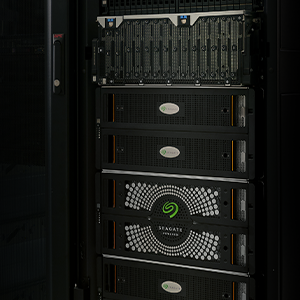In this blog post, we discuss key data-loss prevention tips and the causes of various types of data loss, including laptop, database, server, and tape data. We also explore how Seagate Rescue Data Recovery Services helps recover data from Seagate hard drives across a wide range of formats. Whether dealing with mechanical failure or accidental deletion, our guide provides valuable insights on safeguarding and restoring your data with confidence.
What is data loss?

Data loss refers to the unexpected loss of critical data, preventing users from accessing or utilizing their information as intended. This issue can manifest in several distinct ways:
- Inaccessibility. The inability to retrieve data from a previously functioning computer system or backup.
- Accidental deletion. Files are deleted or data control structures are overwritten unintentionally.
- Corruption. Files become unusable due to abnormal device operation or physical damage.
How does it happen? Data loss can result from a variety of factors, but nearly always, they’re caused by one of three main categories:
- Human error. This includes intentional and accidental actions, such as deleting or overwriting files.
- Technical issues. Software bugs, virus damage, and failed updates can corrupt data, making it difficult to access.
- Physical damage. External conditions like power surges, overheating, electrostatic discharge, and physical impacts can cause hard drive data recovery challenges.
Understanding these risks is crucial for implementing effective data-loss prevention strategies and ensuring your data recovery process, such as those offered by Seagate Rescue Data Recovery Services, is set up for success.
General data-loss prevention tips.

Protecting your data from loss is critical to maintaining the integrity and availability of your digital resources. Whether it’s safeguarding against hardware malfunctions, software issues, or human errors, the following tips provide a comprehensive approach to minimize risks and protect your data.
Software and hardware.
Effective management of your digital environment is crucial in preventing data loss. Here are some structured approaches to safeguarding your data:
- Documentation and archiving. Keep detailed records of your systems and safely archive original copies of your software. This precaution allows you to access unaltered versions in case of data corruption.
- Regular backups. It’s essential to back up your files routinely. Use external hard drives or external SSDs for their reliability and ease of access. Always verify your backups are complete and reflect the original data accurately.
- Software and hardware upgrades. Before upgrading any software or hardware, make sure you have a complete and verified backup. This safety net allows you to restore your system to its previous state if the new setup fails.
- Security measures. Implement firewalls and robust virus protection to guard against malware and unauthorized access that could lead to data loss.
- System maintenance. Regularly delete unused files and applications to maintain system efficiency. Utilize a drive defragmenter—typically included in your operating system’s utilities—to optimize the storage space and improve system performance.
System restore points and backups.
Both Mac® and Windows® offer critical safeguards by maintaining copies of previous versions of your system before changes happen. Utilizing these features prior to making changes can help reduce the risk of losing important data:
- For Windows users. Establish System Restore Points before making significant changes to your system. System Restore Points are snapshots of your computer’s system files, settings, and applications at a specific time, allowing you to revert the system back to a previous state, if something goes wrong with an update or installation.
- For Mac users. Utilize Time Machine—the built-in backup and recovery feature of macOS—to automatically save copies of your files, applications, and system files to an external drive or network location. This makes it possible to recover your entire system or specific files to a previous state, if necessary.
Data storage environment.
The physical environment where your data is stored is pivotal in preventing data loss. Proper environmental management can significantly reduce the risk of hardware malfunctions and data corruption. Here’s how to promote optimal conditions:
- Stable conditions. Maintain a stable temperature, humidity, and cleanliness to protect your equipment. Such measures prevent overheating, moisture damage, and dust-related issues that can lead to hardware failures.
- Physical security. Secure your systems physically to protect them from unauthorized access or theft. This includes locking server rooms and securing workstations against intruders.
- Disaster preparedness. Anticipate physical disasters by implementing robust disaster recovery plans. This should include using off-site storage for critical backups to make sure data is recoverable, even if the primary site is compromised.
Next steps in data recovery.
The following sections will look deeper into the specific types of data recovery services offered by Seagate, such as RAID data recovery, digital photo recovery, and VMWare workstation data loss.
Hard drive data recovery—risks and solutions.

With their portability and exposure to various environmental factors—such as heat, water, and dust—laptop computers are particularly susceptible to hard drive data loss. While these devices are indispensable for fieldwork, their frequent movement and usage in diverse settings make them prime candidates for data loss.
Common causes and symptoms of hard drive data recovery issues.
Data loss in hard drives—particularly in laptops—also occurs based on the three categories mentioned previously:
Physical damage.
- Dropped notebooks might no longer turn on, or they might exhibit mechanical and electrical failures.
- Damage due to fire, liquids, or contaminated media surfaces can cause significant harm to the hard drive.
Software issues.
- Corruption within the system software can prevent applications from loading or running properly.
- Virus attacks can corrupt data and make drives or partitions inaccessible.
Human error.
- Accidental deletion of data can result in critical information being lost.
- Likewise, accidental reformatting of partitions can remove all stored data without any intention of doing so.
Each of these scenarios requires a specialized approach to recover lost data. Seagate Rescue Data Recovery Services offers tailored solutions for hard drive data recovery, retrieving your data even from the most challenging situations. Whether you’re dealing with a crashed hard drive or damage due to environmental factors, our services provide a reliable means to restore your essential data and minimize downtime.
Hard drive recovery across all drive types.
Seagate data recovery services are equipped to handle hard drive recovery for any device—laptops or desktops that utilize Seagate hard drives. Our team is experienced in navigating the complexities associated with various types of drives, so your data is recovered efficiently and effectively.
Best practices for hard drive maintenance.

Regular practices that protect your hard drive echo what was mentioned earlier about maintaining the safety and integrity of your systems.
Here’s how to protect your hard drives:
- Regularly back up your data. Consistently back up your data to protect against unexpected failures. This is the first and most crucial step in safeguarding your data.
- Clean and organize your files. Regularly removing unnecessary files keeps your hard drive uncluttered. This helps reduce the load on your hard drive and improves its efficiency.
- Defragment your hard drive regularly. Periodically defragment your hard drive to consolidate data. Hard drive defragmenting enhances access speed. (For SSDs, however, skip defragmentation as it can reduce the drive lifespan.)
- Monitor hard drive health. Use diagnostic tools to check the health of your hard drive regularly. Tools like SMART (self-monitoring, analysis, and reporting technology) can provide early warnings of potential failures.
- Plan for contingencies. Develop a robust contingency plan for data recovery in case of hard drive failure. Partnering with services like Seagate Rescue Data Recovery Services means you have professional support ready to recover your data swiftly and effectively.
By following these best practices, you can maintain your hard drive in top condition, reducing the likelihood of performance issues or data loss. Since nothing is perfect, having a hard drive recovery plan will help you quickly restore lost data and maintain continuity in your operations.
Database recovery.

Mission-critical data is often housed within sophisticated database systems—such as SQL Server, Oracle®, Sybase®, Exchange Server, and Access—which are integral to the networked file servers that support modern IT infrastructures. These relational and object-oriented database management technologies are crucial, underpinning core applications that drive corporate operations.
Like the hard drives found in personal computers and workstations, the individual media in database servers are vulnerable to similar points of failure. System administrators and database administrators know maintaining a database environment’s integrity requires a robust, well-tested backup strategy.
Despite these precautions, databases can still suffer from corruption that goes beyond the reach of standard recovery techniques:
- The database engine may not recognize backup files.
- Databases may become locked as ‘suspect,’ preventing any access.
- Critical tables might be deleted or dropped.
- Records could be accidentally deleted.
- Database files and devices might become corrupted.
- Individual data pages could be damaged.
- Database files and devices may be accidentally overwritten.
Seagate Rescue Data Recovery Services excels in restoring access to data that has become inaccessible, adeptly handling data recovery for even the most complex database configurations.
Supported database types.
Seagate Rescue Data Recovery Services can recover data from a wide range of database types, including:
- Microsoft® SQL Server (versions 6.5 through 2008)
- Oracle (Lite, 8.x, 9.x, 10x, 11x)
- Sybase SQL Server and SQL Anywhere
- Interbase®, MySQL, PostgreSQL standard databases
- Microsoft Access
Seagate Rescue Data Recovery Services also extends recovery services to all xBase products such as dBase and FoxPro, as well as productivity applications like Microsoft Office (Word, Excel, PowerPoint), mail server and client applications (Microsoft Exchange and Outlook), and email systems adhering to the UNIX mbox format, including Eudora® and Netscape®.
Server data recovery.

Servers—the backbone of modern business operations—store data that powers daily activities. Despite robust protection measures, servers are still vulnerable to a range of failures:
- Configuration corruption in server storage systems (lost config, re-initialized RAID, misplaced drives, etc.).
- Intermittent or multiple drive failures leading to data, file system, and application corruption.
In response to these critical situations, SRS provides priority handling, on-site and remote data recovery, and 24×7 critical services to ensure quick and secure data retrieval. SRS supports a broad array of server operating systems, including those from Microsoft, Apple®, various UNIX and Linux distributions, AIX®, Netware, and more.
Virtual technologies.
Seagate Rescue Data Recovery Services offers comprehensive data recovery options for virtual environments like VMware® (ESX/ESXi and vSphere) and Microsoft Hyper-V, among other hypervisors. The added layers of complexity in virtual environments—such as hypervisor and VM-level failures—include:
- Corrupted virtual drive containers (VMDK, VHD), including issues with base files, snapshots, and metadata.
- Damaged guest file systems within those containers.
- Reformatted or corrupted VMFS volumes and other hypervisor-level file systems.
- Deletion of virtual drive container files.
Tape data recovery.

Tape backup systems—essential for long-term data storage—face multiple failure risks:
- Mechanical failures corrupting tape headers or damaging the tape itself (stretching and snapping).
- Environmental damage from fire, water, or contamination.
- Logical errors from backup software corruption.
- Media degradation due to aging or improper storage.
These failures often lead to catastrophic data loss, especially when legacy tapes become unusable due to outdated hardware or software.
Supported formats and manufacturers.
Seagate Rescue Data Recovery Services has expertise in recovering data from a wide array of tape media and formats, ensuring compatibility with most backup software and tape types:
- Digital linear tapes (DLT, Super DLT, VS series).
- Linear tape-open (LTO) formats from LTO-1 to LTO-5.
- Various other formats, including 4mm DAT (DDS through DAT-320), exabyte 8mm tapes, Sony® AIT series, Travan, QIC, and IBM® 3480/3490/3592 tapes.
Tape backup and file formats.
Seagate Rescue Data Recovery Services supports recovery from backups created with diverse file formats and applications, ensuring broad compatibility across platforms:
- Microsoft tape format (MTF) utilized by NT Backup, Symantec® (Seagate/Veritas) BackupExec.
- System independent data format (SIDF) used by Novell® and Palindrome®.
- Comprehensive support for IBM Tivoli TSM, CA Brightstore® (Arcserve), EMC® (Legato) NetWorker, Symantec (Veritas) NetBackup, and traditional UNIX/Linux archiving utilities (tar, cpio, etc.).
Protect your data with Seagate Rescue Data Recovery Services.
Experiencing data loss or a hard drive failure can be disastrous, impacting everything from daily operations to critical business decisions. Seagate Rescue Data Recovery Services offers a lifeline with experienced professionals who utilize advanced recovery techniques and tools to restore data from all types of enterprise hard drives, databases, and servers. Whether a mechanical failure or a corrupted file system, our team is equipped to handle the most challenging recovery scenarios.
For more information, please go to Seagate Rescue Data Recovery Services.
Database, server, and hard drive data recovery FAQ.
Find answers to common questions about database, server, and hard drive data recovery. These frequently asked questions cover the topics of how long recovery typically takes, can data be recovered from a corrupt drive, and how Seagate Rescue Data Recovery Services work.
1. What is hard drive data recovery, and when is it needed?
Hard drive data recovery is the process of restoring data that has been lost, accidentally deleted, or rendered inaccessible due to hardware or software failures. It is needed after data loss incidents to recover critical information.
2. How long does the data recovery process typically take?
The duration of the data recovery process can vary depending on the extent of the damage and its complexity. Still, Seagate Rescue Data Recovery Services works efficiently to minimize downtime and restore your data as quickly as possible.
3. What should I do to prevent future data loss on my server?
To stop data loss in the future, implement regular backups, maintain updated antivirus software, and employ robust firewalls to safeguard your data. Seagate Rescue Data Recovery Services also offers consultations on best practices for data preservation and disaster recovery planning.
4. How can lost data from a corrupted database be recovered?
Seagate Rescue Data Recovery Services can often recover lost data from a corrupted database because it employs specialized techniques and tools to restore data and establish database integrity.
5. Can I perform hard drive data recovery at home, or should I seek professional help?
While some minor data recovery tasks can be performed at home, professional assistance from Seagate Rescue Data Recovery Services is recommended for severe data loss situations to allow for the highest chance of recovery without risking further damage.
















